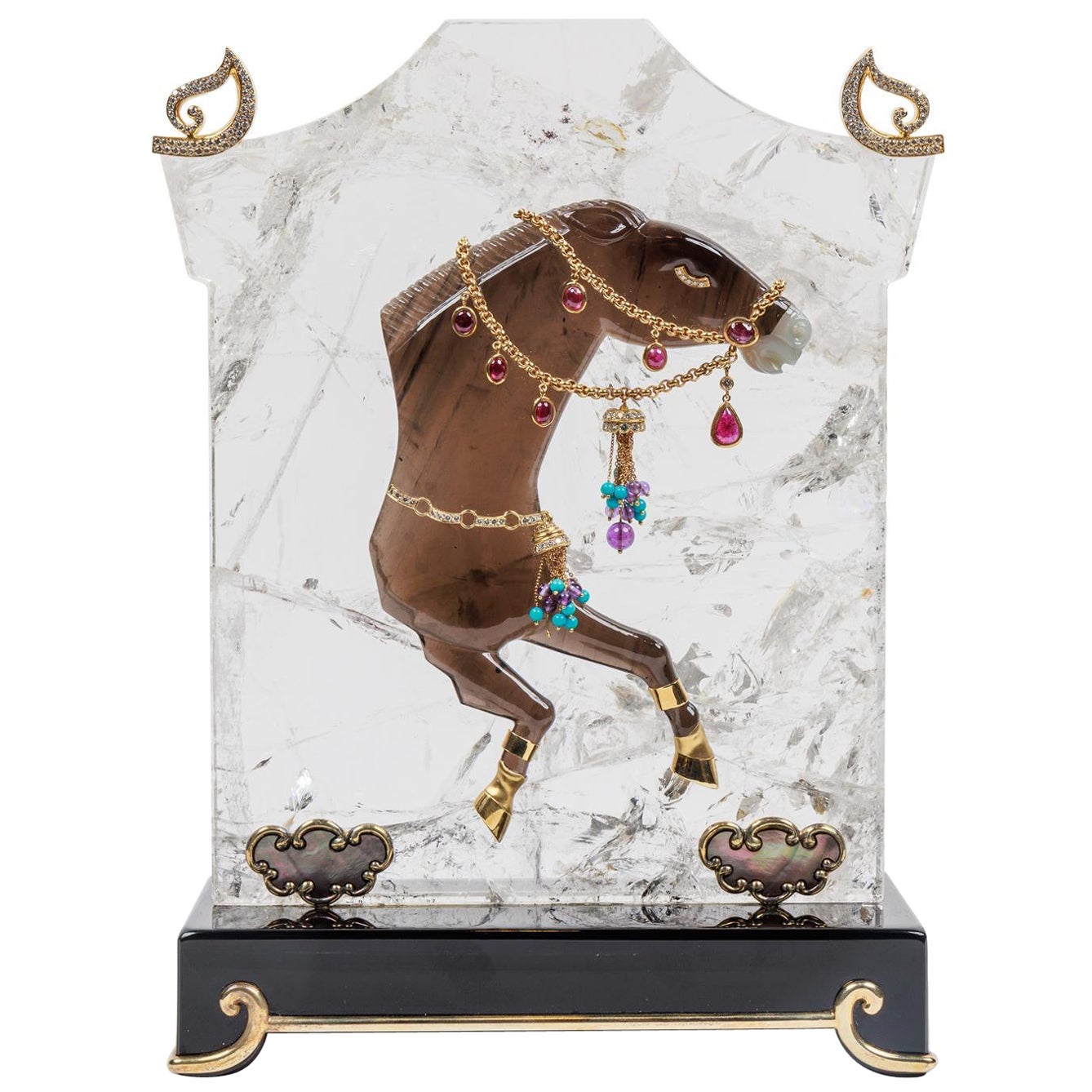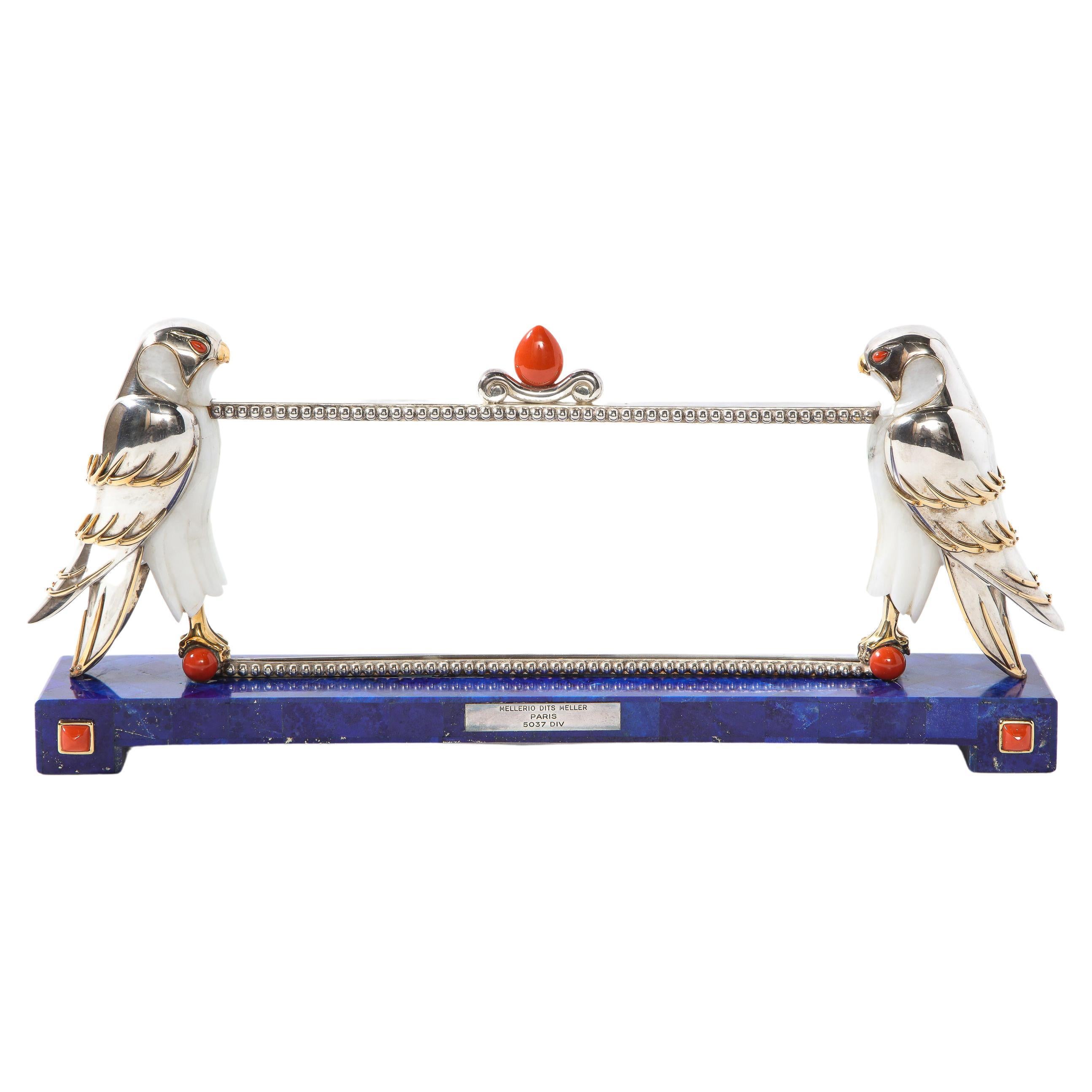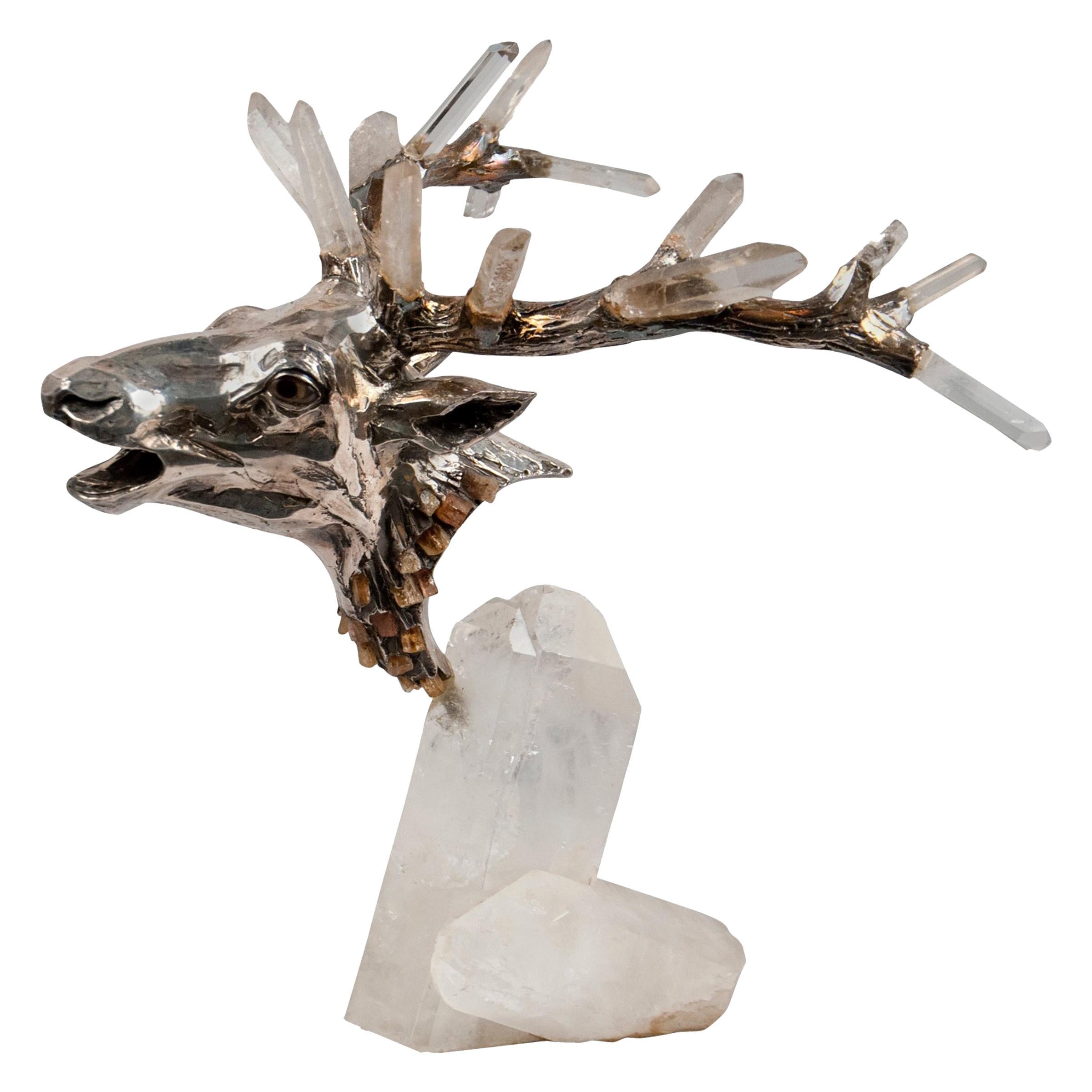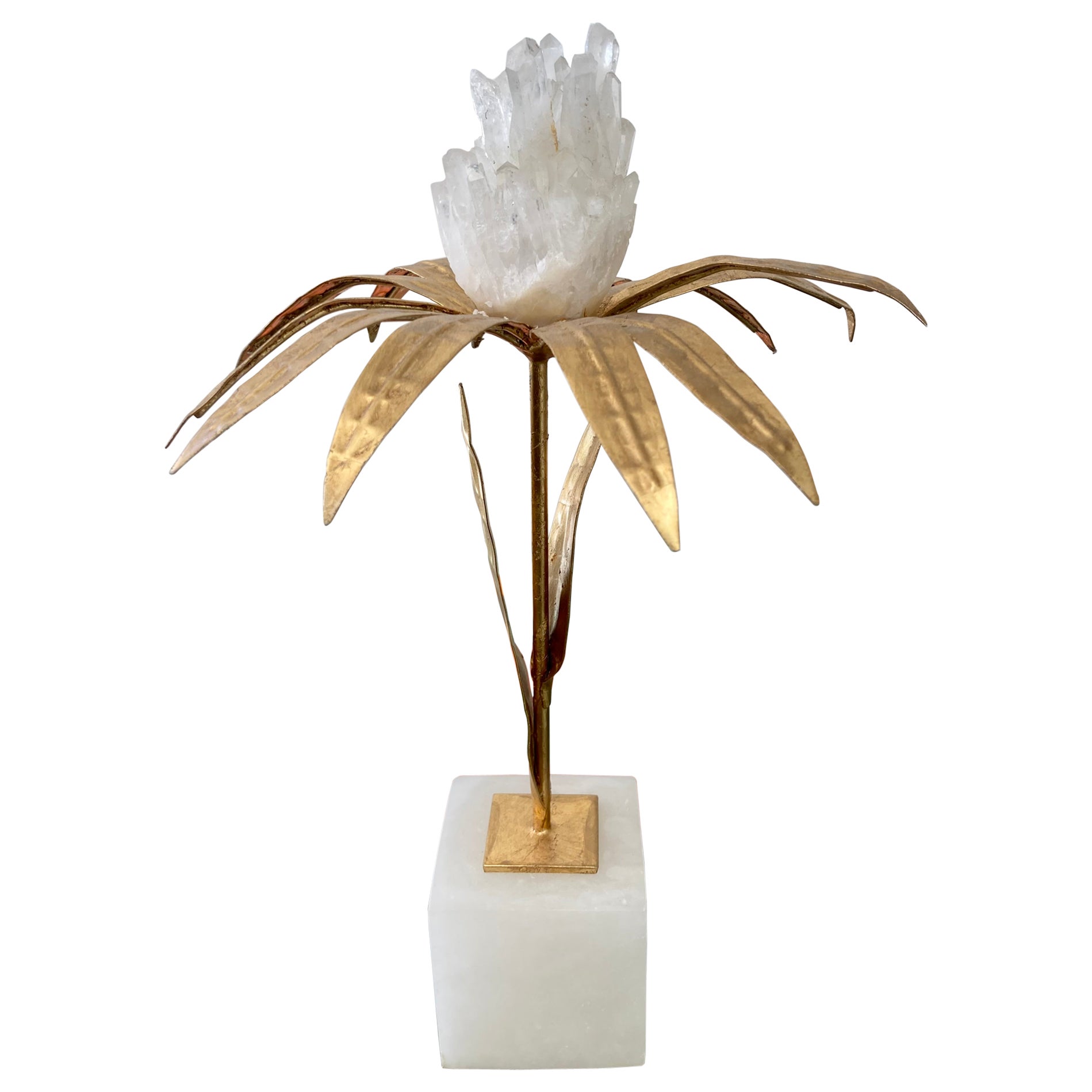Mellerio Paris, A French Gold, Diamond, Silver-Gilt, Rock-Crystal, & Lapis Horse
About the Item
- Creator:Mellerio (Jeweler)
- Dimensions:Height: 10 in (25.4 cm)Width: 9 in (22.86 cm)Depth: 4 in (10.16 cm)
- Materials and Techniques:
- Place of Origin:
- Period:
- Date of Manufacture:circa 1998
- Condition:
- Seller Location:New York, NY
- Reference Number:1stDibs: LU1798227704682
Mellerio
With a history spanning more than 400 years, Mellerio is officially the oldest jewelry house in France. Known for their timeless and exquisite bracelets, rings, brooches and other pieces, Mellerio has counted the likes of Queen Victoria, Marie-Antoinette, Marie de' Medici and other historically important figures as clients.
Mellerio’s story began in 1613 with members of the Mellerio family — descendants of Italian immigrants — who worked as goldsmiths in Paris. During the late 18th century, Jean-Baptiste Mellerio (1765-1850) sold his jewelry and trinkets in town fairs and near royal residences around France. Outside of the Palace of Versailles, his finely crafted jewelry caught the eye of Marie-Antoinette, who reportedly bought a bracelet featuring seven cameos surrounded by rubies.
Marie-Antoinette’s patronage helped broaden Mellerio’s reach as a jeweler for many French nobles and aristocrats, and, in 1796, he opened a store at 20 Rue Vivienne in Paris. In 1800, the business relocated to the Rue du Coq St. Honoré near the Tuileries Palace and, in 1832, moved again to 9 Rue de la Paix.
Today, Mellerio is owned and operated by the 15th generation of the Mellerio family. From their workshop above their historic boutique at 9 Rue de la Paix, they specialize in creating jewelry in styles such as Art Nouveau and Art Deco that is set with diamonds, rubies, emeralds, sapphires and more.
Among Mellerio’s most coveted pieces are its decorative boxes and cases, gold and silver-gilt figurines and sculptures, dazzling bands and engagement rings. Their fine jewelry collection also features an impeccable array of bracelets, necklaces, earrings and a range of watches.
Throughout Mellerio’s illustrious history, the house has participated in numerous exhibitions, including the World Exhibitions in London in 1862, Paris in 1867, Vienna in 1873 and again in Paris in 1878 and 1900. Mellerio exhibited at the Exposition Internationale des Arts Décoratifs et Industriels Modernes in 1925, which brought Art Deco to a global stage, and the New York World’s Fair in 1939.
Mellerio dits Meller continues its long-standing legacy as one of the world’s finest jewelers, attracting royalty, celebrities and discerning collectors of luxury adornments.
On 1stDibs, discover a range of antique and vintage Mellerio jewelry and objets d’art and vertu.
- ShippingRetrieving quote...Ships From: New York, NY
- Return PolicyA return for this item may be initiated within 7 days of delivery.
- Mellerio Paris, A French Gold, Diamonds, Silver, and Smoky Quartz Carved HorseBy MellerioLocated in New York, NYMellerio Paris, A French Gold, Diamonds, Silver-Gilt, Rock-Crystal, Jade, Mother-Of-Pearl and Smoky Quartz, Carved Horse Sculpture, Jeweled Mounted Object. An extremely rare and unique, one of a kind French gold, diamonds, Silver-gilt, rock-crystal, jade, obsidian, mother-of-pearl, and smoky quartz carved jeweled sculpture "CHEVAUX DE LEGENDE", "A Legendary Horse" by Mellerio, Paris, circa 1991. Sitting on black obsidian base, the solid rock-crystal slab is finely applied with a carved smoky -quartz and jade horse with a harness mounted in 18k gold, brilliant -cut diamonds, rubies, turquoise, and amethyst chains and pendants. The top columns adorned with 18k gold and brilliant cut diamond pendants, the bottom with gold and mother of pearl plaques. The obsidian base with a plaque engraved: CHEVAUX DE LEGENDE" / N° 05 / MELLERIO DITS MELLER / PARIS / 5003 D The piece is in excellent condition and comes with a custom made wood case made for transport. It's very elegant and has French hallmarks throughout. A truly magnificent piece. Measures 10.5" high x 8.5" wide x 4" deep Founded in France in 1613 by the descendants of Italian immigrants from the Vigezzo Valley in the north of Italy, Mellerio is one of the oldest jewellery houses in Europe. The family business soon attracted the attention of the Royal Court and Marie Antoinette herself reportedly purchased a precious bracelet featuring 7 cameos surrounded by rubies in 1780. Later on, in the 19th century, Mellerio became the official supplier of the French Royal family and the Court of Netherland. Mellerio creates many jewellery items, all set with rare gems such as peridots, amethysts, aquamarines, citrines and topaz, applying for a patent, the flexible stem, a very supple and light jewellery mechanism. Mellerio remains also well known for their spectacular series of Art Nouveau jewels, created at the beginning of the 20th century, as well as for the creation of trophies rewarding some of the greatest footfall and tennis players of history. In 1993, the jewellery house launched their first watch collection. Today, Mellerio has stores in Paris, Japan and Hong Kong. July 14, 1789: this date is known throughout the world as the beginning of the French Revolution. According to a ledger belonging to House of Mellerio, this was also the day that the jeweler sold a golden key to the Comte de Coutance for 10 livres. This ledger, as well as inventories dating as far back as 1768, are the jeweler’s oldest archives. These archives have continued to grow over the years, as the House, established on rue de la Paix in Paris, still lives on today, still in the hands of the same family from Craveggia, in the North of Italy. The tumultuous history of the Mellerio family in France probably goes as far back as the Italian wars of the Renaissance, but the first official document proving their commercial activity in Paris dates back to 1613. This document is the famous royal warrant awarded by Marie de Medici to a number of Italian families established along the rue des Lombards, including the Mellerios, allowing them to sell “small jewelery items”, therefore granting them a small exception to the traditional monopoly enjoyed by Parisian jewelers. At that time, powerful corporations regulated the operations and customs of Parisian business, but thanks to this exceptional warrant, the Mellerios managed to escape the confines of this framework. Today, this wax-sealed document is kept at the city hall of Craveggia. From 1613 to the Revolution, the Mellerios lived between France and Italy. The corporations tried many times to put an end to their trade privileges, but all in vain, as a dynasty of sovereigns renewed the warrant. Always marrying and often retiring in Craveggia, the Mellerios continued to maintain their jewelry business in Paris. At first, they did this without a shop. Wearing backpacks (wooden boxes divided into small compartments where jewels were kept), they would tour town fairs around Paris and royal castles. This is how Jean-Baptiste Mellerio (1765-1850) is said to have sold a bracelet set with rubies and Antique cameos to Marie-Antoinette, which still exists today. Many elements seem to prove the veracity of this anecdote. The queen was particularly fond of cameos, which cover the entire background of her famous jewelry cabinet, and ruby was her favorite stone after diamond. The famous bracelet, reacquired a few years ago by the House of Mellerio, is indeed an 18th century jewel, set with antique cameos representing the profiles of Roman emperors. Two branches of the family were operating in Paris during this time, under the reign of Louis XVI: that of Jean-François (1746-1828), the paternal ancestor of the current Mellerios, and that of Jean-Baptiste (1765-1850). The French Revolution forced them to return to Italy. However, both Jean-Baptiste and François Mellerio (1772-1843), who was the son of Jean-François, were eventually able to return to Paris after the founding of the Consulate. Jean-Baptiste opened a shop at the Iron Crown of rue Vivienne, and François opened his at the Palais des Tuileries, rue du Coq Saint-Honoré. His well-organized order books give an idea of his high-ranking clientele during the “Old Regime”, among which were the Comte and Comtesse Octave de Segur, the Marquise (later Duchess) de Tourzel, former governess of the royal children, and her daughter, the Comtesse de Bearn, the Craufurds -who organized the flight to Varennes, the Duc and Duchess de Gramont, the Comtesse de Boigne, and Madame de Souza, Talleyrand’s mistress. We also see the names of the imperial family: Empress Josephine, the Queen of Holland, Princess Elisa, Caroline and Pauline. At that time, the House of Mellerio specialized, among other things, in the trade of antique cameos, a newly fashionable genre of jewel that captured the imagination of all the princesses and noble women of the time. The years of the Restauration and July Monarchy were among the most glorious. The Bourbons were back on the throne, and the clientele of the House of Mellerio had regained its former wealth. Mellerio supplied Louis-Philippe, Duke of Orléans, as well as his mother, wife and sister, with sumptuous jewels, including a set of emeralds made piece by piece, while the Duke of Bourbon, last prince of the House of Condé, offered diamonds to his mistress, the scheming Baronne de Feucheres, and Monsieur de LaFayette also bought cameos for one of his granddaughters. For the first time, Mellerio ventured into the world of arts in 1815, when Carlotta Grisi, a famous dancer who created Giselle, as well as an actress named Rachel, bought jewels at the Mellerio store on rue de la Paix. 1848 marked a new turning point. France once again became a Republic. François Mellerio handed the company over to his son, Jean, and the latter decided to travel to Spain to build a new clientele. He later became one of the jewelers of the royal family, and met Eugénie de Montijo, who remained a faithful client when she became empress of the French people. The Imperial years were lavish. During the Second Empire, Paris was a pageant of crinoline dresses designed by Worth, while jewels by Mellerio, Worth’s neighbour on the rue de la Paix, adorned the noble women of the Tuileries court. The Empress bought pearls. Mathilde Bonaparte...Category
20th Century French Mounted Objects
MaterialsJade, Quartz, Rock Crystal, Gold, Silver
- Mellerio Paris, a Silver, Gold, Lapis Lazuli, Coral, and Hardstone Picture FrameBy MellerioLocated in New York, NYMellerio Paris, a large silver, gold, lapis lazuli, coral, and hardstone picture photo frame with two falcons. France, circa 2000 The frame resting on a lapis lazuli base with squa...Category
21st Century and Contemporary French Picture Frames
MaterialsCoral, Lapis Lazuli, Silver
- Chaumet Paris, a French Silver-Gilt Seahorse Mounted Rhodochrosite CupBy ChaumetLocated in New York, NYChaumet Paris, A French Silver-Gilt Seahorse Mounted Rhodochrosite cup Circa 1980. An exceptional object A quadrangular cut cup in rhodochrosite and the handle made of a sea...Category
Late 20th Century French Brutalist Mounted Objects
MaterialsSterling Silver
- Exquisite Italian Silver-Gilt, Diamond, Rock Crystal, & Rhodochrosite MirrorLocated in New York, NYAn Exquisite Italian Silver-Gilt, Diamond, Rock Crystal, and Rhodochrosite Vanity Mirror, by Moba Italy. Circa 1950 Very fine and impressive vanity mirror made in solid sterling gi...Category
20th Century Italian Table Mirrors
MaterialsRock Crystal, Silver
- Enamel Gold and Rock Crystal Figure of Emperor Maximilian I by Reinhold VastersLocated in New York, NYA rare enamel, gold and rock crystal figure of Emperor Maximilian I by Reinhold Vasters, Aachen, In the Renaissance style, circa 1870. The g...Category
Antique Late 19th Century German Renaissance Figurative Sculptures
MaterialsRock Crystal, Gold, Enamel
- Rare Carved Hawk's Eye Agate Tiger on a 14K Gold Mounted Rock Crystal BaseBy CartierLocated in New York, NYA rare carved Hawk's Eye agate tiger on a 14k gold mounted rock crystal base, circa 1960. "A Jeweled Sculpture" An incredible carved tiger made...Category
20th Century German Animal Sculptures
MaterialsAgate, Rock Crystal, Gold
- Deer Head by Mellerio dits Meller 'founded 1613' France, circa 1980By MellerioLocated in New York, NYFinely crafted deer head executed in .950 silver, the antlers and chest are adorned with small crystal prisms, raised on a rock crystal cluster. Incised “Mellerio” “AMADOR NO. 10-25...Category
Vintage 1980s French Modern Natural Specimens
MaterialsRock Crystal, Silver
- French Gilt Palm Tree With Rock Crystal LowerLocated in Los Angeles, CAGorgeous French gilt palm tree with rock crystal detail and marble base. Beautiful table top accessory with a luxury element. We have 4 slightly different styles available. Collect a...Category
Early 2000s French Modern Figurative Sculptures
MaterialsMarble, Metal
- Neoclassical Grand Tour Style Rock Crystal Obelisk Silver Gilt MountLocated in Atlanta, GAMonumental mine harvested rock crystal obelisk specimen mounted to a silver gilt wood base. Measure: 33".Category
20th Century Natural Specimens
MaterialsRock Crystal
- Rock Crystal Obelisks, Pair, FrenchLocated in Montreal, QuebecFine large pair of neoclassical rock crystal obelisks with square base. Very harmonious proportions, exquisite clarity, Fren...Category
Early 20th Century French Neoclassical Obelisks
MaterialsRock Crystal
- French Gilt Palm Tree With Rock Crystal and Marble Base MediumLocated in Los Angeles, CAGorgeous French gilt palm tree with marble base. Beautiful table top accessory with luxury elements. We have 4 similar sizes available. Collect all 4.Category
Early 2000s French Modern Figurative Sculptures
MaterialsMarble, Metal
- French Gilt Palm Tree With Rock Crystal and Marble Base - TallLocated in Los Angeles, CAFrench gilt palm tree with rock crystal and marble base. Beautiful table top accessory with luxury elements. We have 4 similar sizes available, collect all 4.Category
Early 2000s French Modern Figurative Sculptures
MaterialsMarble, Metal






